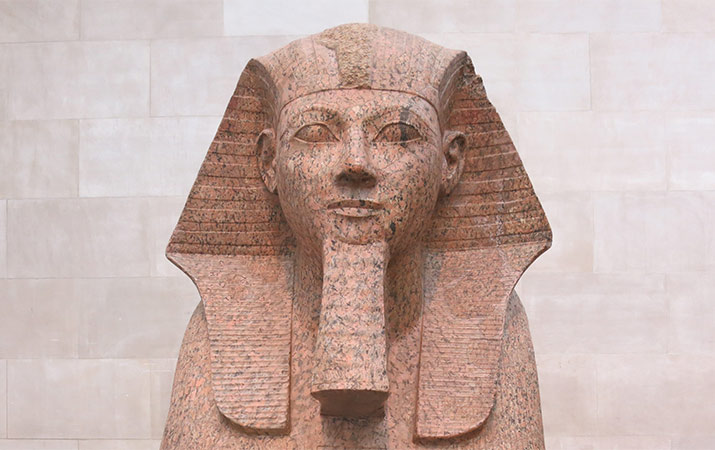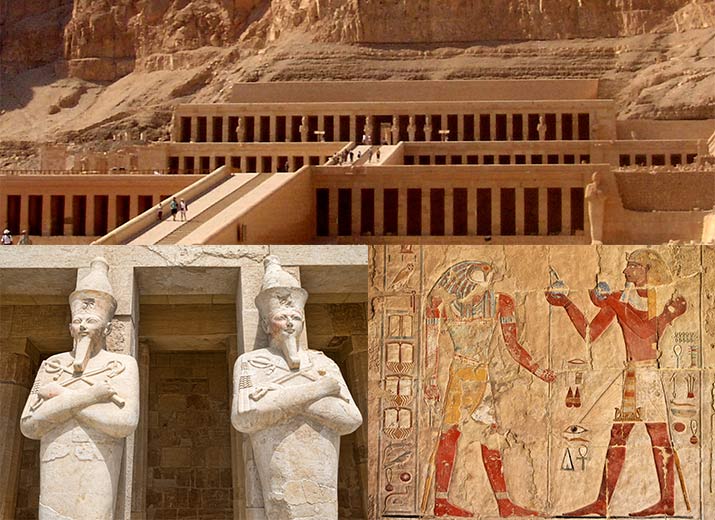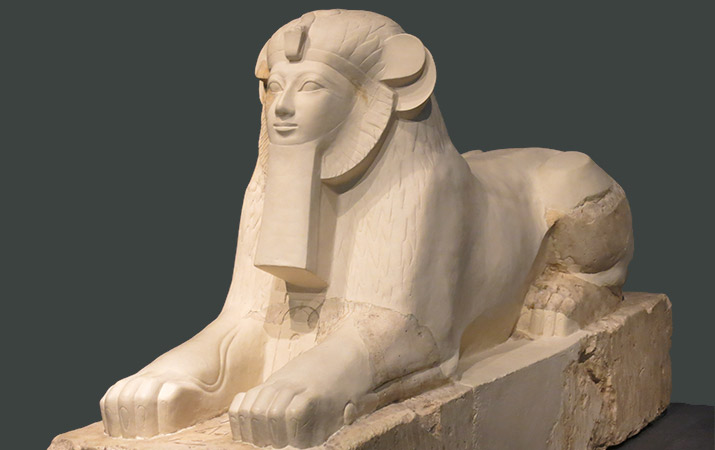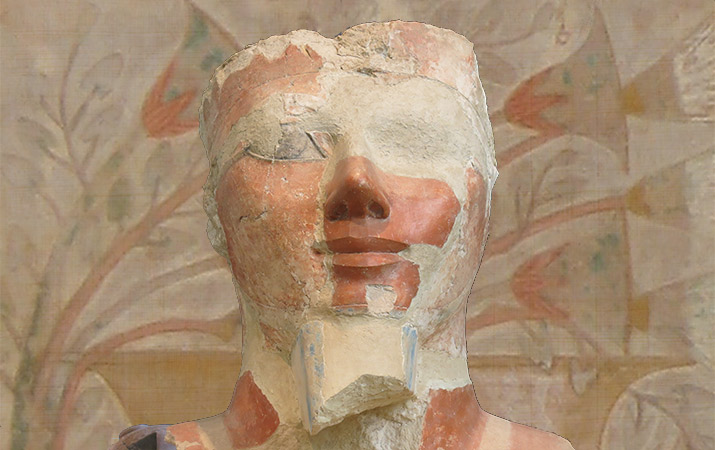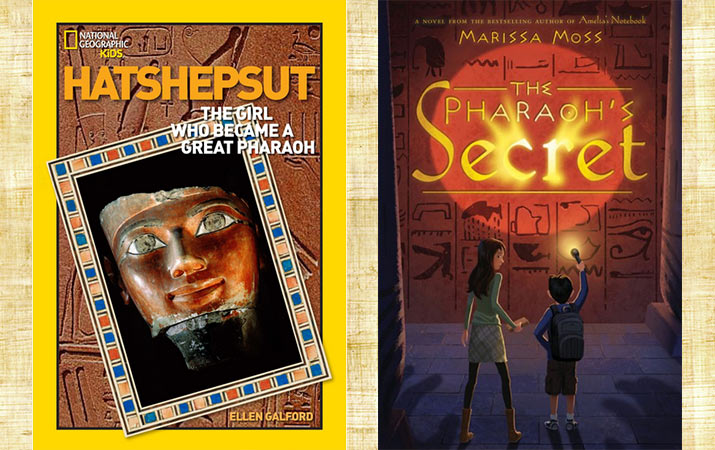In ancient Egypt, Hatshepsut was unique – born a royal princess, she became Queen, and then … was crowned Pharaoh, a king descended from the gods.
The Metropolitan Museum of Art in New York has an extensive ancient Egypt collection, and one gallery is filled with magnificent statues of Hatshepsut.
How the statues and Hatshepsut’s extraordinary life were discovered is quite a story.
Hatshepsut lived in a golden age of Egypt, New Kingdom 18th dynasty, which includes other famous pharaohs and queens such as Thutmose III, Nefertiti, and Tutankhamun. Unlike Tutankhamun, Hatshepsut has no treasure-filled burial tomb, but she constructed a magnificent rock-cut temple at Deir el-Bahri.
When Hatshepsut died, she was buried with full honors befitting a pharaoh, next to her dad, Thutmose I. However, after her stepson succeeded her as pharaoh, Hatshepsut’s many statues were smashed and destroyed, her cartouches and reliefs gouged out of the stone. She sort of disappeared.
Deir el-Bahri
The Temple of Hatshepsut at Deir el-Bahri in Egypt was a temple for religious rituals, to commemorate important events in Hatshepsut’s reign, and portray her divine connection to the gods.
Over the centuries, Deir el-Bahri was covered up – it was a ruin when archaeologists arrived in the 19th century. But long term excavations revealed the majestic temple structure, monumental statues and glowing reliefs.
On the upper terrace stood a whole row of statues, Hatshepsut’s head and a mummy body of Osris, her arms crossed holding a crook and scepter. As pharaoh, descended from the gods, here she is associated with Osiris, lord of the underworld.
In the chapel of Anubis, on a painted relief Hatshepsut is shown wearing the pharaoh headdress and kilt, and making offerings to the sun god with a falcon head.
Also in the temple is an inscription from the high god Amon to Hatshepsut -“Welcome my sweet daughter, my favorite, the King of Upper and Lower Egypt, Maatkare, Hatshepsut. Thou art the King, taking possession of the Two Lands.”
As archaeologists deciphered hieroglyphics, and began to understand the history of ancient Eygpt, the name Maatkare Hatshepsut appeared, but was very confusing. Pharaohs were assumed to be male, but Hatshepsut means “foremost of women.”
Over time, through research at Deir el-Bahri, many documents, hieroglyphs, and artifacts, Hatshepsut emerged, the life of a female pharaoh.
Hatshepsut Met Gallery
In the 1920’s, while excavating around the Temple of Hatsepsut at Deir el-Bahri, Metropolitan Museum of Art archaeologists found a junk pit with hundreds of huge statues, broken into pieces.
The archaeologists discovered these were all statues of Hatshepsut, smashed to bits eons ago.
Imagine the work to reconstruct all the Hatshepsut statues you’ll see in this gallery!
In every statue, Hatshepsut is portrayed with the symbols of a pharaoh – crown of Upper and Lower Egypt, protective cobra (uraeus) on her forehead, false beard on her chin, striped nemes or soft khat headdress, male kilt, her skin painted red.
She is also shown in different poses – kneeling with offerings or gifts to the god Amon, standing quietly with her hands in devotion, as a sphinx with her face and a lion mane.
Equally important, Hatshepsut’s face is quite feminine and lovely, with wide almond shaped eyes, and she is smiling.
In the museum, Hatshepsut statues are room 115. Next door, room 116, see Hatshepsut scarabs, room 118 has more goodies from the 18th dynasty, including gold sandals and jewelry, similar to things Hatshepsut might have worn. The large Hatshepsut sphinx (head at top of the post) is located next to the Temple of Dendur, room 131.
Tip: For more about Ancient Egypt at The Met, and Cleopatra’s Needle in Central Park, read our blog post: Ancient Egypt in New York
Children’s books
- Hatshepsut: The Girl Who Became a Great Pharaoh by Ellen Galford.
- Extraordinary true story of Hatshepsut, from the day of her birth through her reign as pharaoh – she launched trading expeditions, piled up wealth and treasures, and rule Egypt for over 20 years. Plus info about ancient Egyptian gods and goddesses, feasts and festivals, tombs and palaces, daily life. (Illustrated chapter book)
- Hatshepsut of Egypt by Shirin Yim Bridges, Albert Nguyen.
- Picture book biography of Hatshepsut, growing up in the royal palace, marrying, and then after her husband the pharaoh dies, she is declared Pharaoh. (Picture book)
- The Pharaoh’s Secret by Marissa Moss.
- Travel with Talibah and her brother Adom to Luxor and step into a mystery surrounding Hatshepsut and her advisor Senenmut. Riddles, hieroglyphs, a villainous archaeologist, and the great monuments of Deir el-Bahri and temple of Karnak, this adventure is the next best thing to a trip to Egypt. (Chapter book)
- Egyptian Diary by Richard Platt, David Parkins.
- 1464 BC. Nakht, studying to be a scribe, keeps a journal of his adventures in 18th dynasty Egypt. Along with a hippo hunt, visiting Giza, discovering a tomb robbery, Nakht and his sister meet Pharaoh Hatshepsut. Wonderful illustrations and historical details. (Chapter book)
- Ancient Egypt: Tales of Gods and Pharaohs by Marcia Williams.
- Nine stories of gods and pharaohs, including a story of Hatshepsut. At her birth, Hatshepsut is visited by the god Amon Re and the goddess Hathor weaves the web life for her, foretelling her destiny as pharaoh. (Picture book)
- 1,000 Facts about Ancient Egypt by Nancy Honovich.
- Fascinating and comprehensive fun facts about ancient Egypt – mythical gods and goddesses, style, beauty and jewelry, celebrations, making mummies, female rulers, food, weapons and war, amazing finds, lost cities, and more. Tip: Find out how Egyptian dentists filled cavities. (Chapter book, tons of photographs)
Tip: And find more fun things to do with kids in New York City on Travel for Kids, and our list of fun places to stay: New York family hotels.

